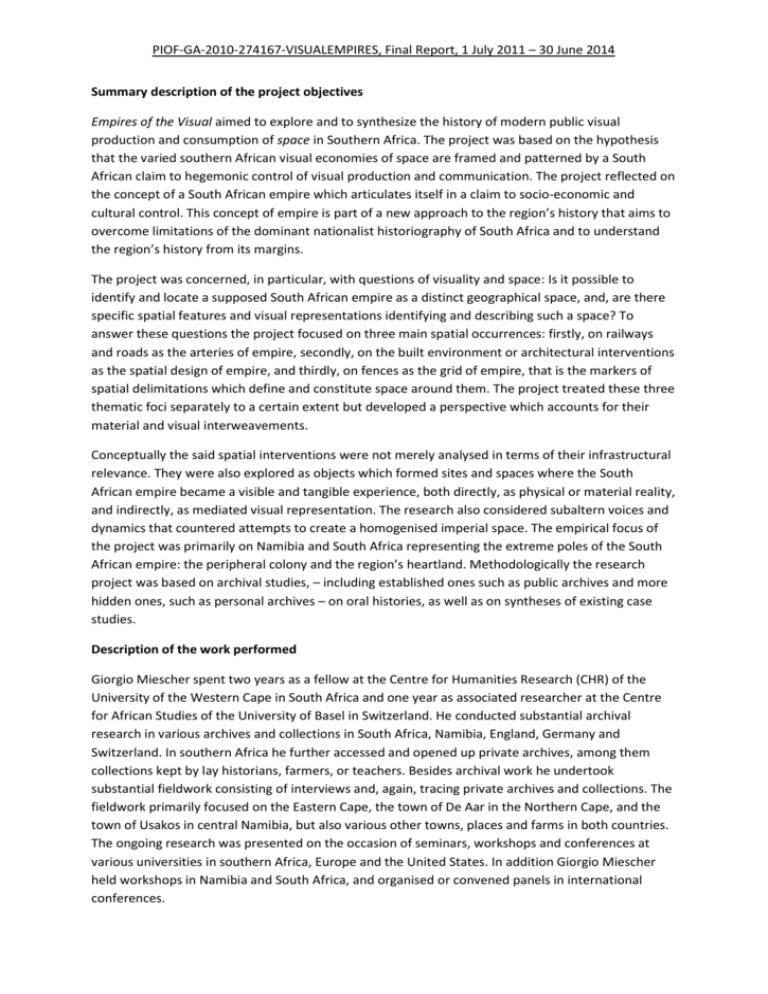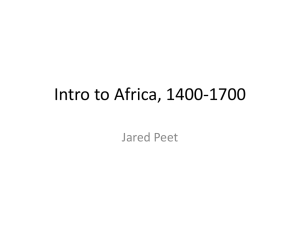final1-visualempires-final-report
advertisement

PIOF-GA-2010-274167-VISUALEMPIRES, Final Report, 1 July 2011 – 30 June 2014 Summary description of the project objectives Empires of the Visual aimed to explore and to synthesize the history of modern public visual production and consumption of space in Southern Africa. The project was based on the hypothesis that the varied southern African visual economies of space are framed and patterned by a South African claim to hegemonic control of visual production and communication. The project reflected on the concept of a South African empire which articulates itself in a claim to socio-economic and cultural control. This concept of empire is part of a new approach to the region’s history that aims to overcome limitations of the dominant nationalist historiography of South Africa and to understand the region’s history from its margins. The project was concerned, in particular, with questions of visuality and space: Is it possible to identify and locate a supposed South African empire as a distinct geographical space, and, are there specific spatial features and visual representations identifying and describing such a space? To answer these questions the project focused on three main spatial occurrences: firstly, on railways and roads as the arteries of empire, secondly, on the built environment or architectural interventions as the spatial design of empire, and thirdly, on fences as the grid of empire, that is the markers of spatial delimitations which define and constitute space around them. The project treated these three thematic foci separately to a certain extent but developed a perspective which accounts for their material and visual interweavements. Conceptually the said spatial interventions were not merely analysed in terms of their infrastructural relevance. They were also explored as objects which formed sites and spaces where the South African empire became a visible and tangible experience, both directly, as physical or material reality, and indirectly, as mediated visual representation. The research also considered subaltern voices and dynamics that countered attempts to create a homogenised imperial space. The empirical focus of the project was primarily on Namibia and South Africa representing the extreme poles of the South African empire: the peripheral colony and the region’s heartland. Methodologically the research project was based on archival studies, – including established ones such as public archives and more hidden ones, such as personal archives – on oral histories, as well as on syntheses of existing case studies. Description of the work performed Giorgio Miescher spent two years as a fellow at the Centre for Humanities Research (CHR) of the University of the Western Cape in South Africa and one year as associated researcher at the Centre for African Studies of the University of Basel in Switzerland. He conducted substantial archival research in various archives and collections in South Africa, Namibia, England, Germany and Switzerland. In southern Africa he further accessed and opened up private archives, among them collections kept by lay historians, farmers, or teachers. Besides archival work he undertook substantial fieldwork consisting of interviews and, again, tracing private archives and collections. The fieldwork primarily focused on the Eastern Cape, the town of De Aar in the Northern Cape, and the town of Usakos in central Namibia, but also various other towns, places and farms in both countries. The ongoing research was presented on the occasion of seminars, workshops and conferences at various universities in southern Africa, Europe and the United States. In addition Giorgio Miescher held workshops in Namibia and South Africa, and organised or convened panels in international conferences. PIOF-GA-2010-274167-VISUALEMPIRES, Final Report, 1 July 2011 – 30 June 2014 Especially the sojourn at the CHR allowed Giorgio Miescher to bring his research into a mutually stimulating conversation with a range of South African and international scholars from various disciplines of the humanities and to develop his research in significant ways. On the one hand, these conversations were pivotal to sharpen the original research agenda into its actual form. On the other hand, these conversations stimulated a growing interest amongst South African scholars to engage with the concept of the South African empire which not least motivated a considerable number of scholars of and from South Africa and neighbouring countries to participate in a conference on the South African empire held in Basel, Switzerland in September 2013. The highly rated event became a highlight for African Studies in Basel. During his stay at the Centre for African Studies Miescher devoted to writing and dissemination he also initiated a follow-up project on historical photographs. Achievements The above-mentioned conference Re-figuring the South African Empire (Basel, 9-11 September 2013) was an important milestone of the project. It brought together scholars from southern Africa, Europe and the United States to explore the potential of approaching 20th century southern African history through the lens of the concept of a South African empire and attracted a lot of interest in the field of African Studies in Switzerland. A selection of the papers will be published as a special issue of the renowned Journal of South African Studies in 2015. The contributions to the conference made clear that ‘thinking with empire’ is a fruitful approach for historians of southern Africa striving to overcome the limits of national(ist) historiographies. The vivid and positive response to the South African empire concept confirmed and further encouraged to develop further its conceptual and theoretical base. During the period of his fellowship Giorgio Miescher finalised the publication of two monographs, and prepared and published two peer-reviewed academic articles. In addition he submitted a paper on architecture and town planning in the South African empire (‘The NE 51 Series Frontier: the grand plan of apartheid architecture and the small town’) to an academic journal and completed a comprehensive and detailed outline of a new monograph (Thinking with Empire: historical geographies of South Africa’s imperial space) which he submitted for consideration to an academic publishing house. Finally, Giorgio Miescher gathered an interdisciplinary group to prepare the realisation of an exhibition and follow-up project based on visual collections accessed and secured in the course of the research. These collections consist of privately kept photographs of mid-20th century African urban life and are of exceptional and unique value. The exhibition will be both on permanent display in Usakos and on temporary display in various venues in southern Africa and Europe. In sum, the project has had a substantial impact on the discussion of southern African history. The proposed paradigmatic shift of thinking with empire offers a perspective to overcome the limitations and constraints of national historiographies and allows for refiguring the past of the region and the single countries. The project explored and demonstrated the potential of the paradigmatic shift by considering the interrelated pasts of Namibia and South Africa. It has further made an important contribution towards the conceptualisation of visuality and space and understanding the relation between the two. It was successful in establishing new and strengthening existing networks of collaboration between institutions and individuals in Europe and southern Africa. Finally, the project also made a visible and significant intervention in the European academic landscape, where a new generation of scholars of the social sciences and humanities has engaged with post-apartheid historiography and socio-political analysis.









